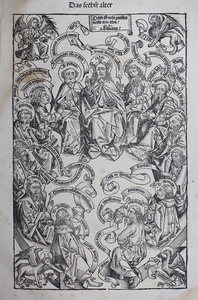| Method | Woodcut |
| Artist | Michael Wolgemut |
| Published | [Anton Koberger, Nuremberg, 1493] |
| Dimensions | Image 380 x 227 mm, Sheet 450 x 305 mm |
| Notes |
A full-sheet woodcut illustration of Christ and the Apostles, from the celebrated Nuremberg Chronicle. The woodcut, likely engraved by Wolgemut himself, is featured as part of Georg Alt's description of the Sixth Age of Man, beginning with the birth of Christ and continuing to Alt's present day in the late fifteenth century. The text accompanying the illustration describes the role played by the Apostles in building the Church and preaching the Word of God around the world. Christ, crowned, haloed, and holding an orb, sits in the centre of the scene, with the twelve Apostles gathered around him in a circle. The names of each are included in their haloes, and a series of banderoles contain a description of the life or Christ, beginning with a scroll at the centre top contains the Saviour's words 'Data est mihi potestas in celo et in terra' - All Power in Heaven and Earth has been given to me. In the four corners of the sheet, the symbols of the Evangelists are shown: an angel for Matthew, the winged Lion of Mark, Luke's ox, and the Eagle of John. The Liber Chronicarum, usually referred to in English as the Nuremberg Chronicle or in German as the Schedelsche Weltchronik, is, after the Gutenberg Bible, likely the most famous of all early printed books. A colossal chronicle of biblical history, the text covered the seven ages of the world, from Creation to the contemporary world of fifteenth century Europe, and the coming of the Last Judgement. The text, written in Latin by Hartmann Schedel and translated by Georg Alt for the German edition, was mostly a composite of earlier biblical, scientific, philosophical, and historical works. What set the Chronicle apart from its contemporaries was less the quality of its text than its illustrations, which were carved in their hundreds by the workshop of Michael Wolgemut. The illustrations for some of these blocks may have been executed by the young Albrecht Durer, who was apprenticed to Wolgemut at the time. Estimates suggest that up to 1500 copies in Latin may have been printed, as well as between 700 and 1000 German copies by the publishing house of Anton Koberger. In an attempt to prevent piracy, the blocks were kept under lock and key, and returned to the patrons of the work following printing. Michael Wolgemut (1434-1519) was a German painter, printmaker, and sculptor, whose significant achievements are now largely overshadowed by his much more lauded pupil, Albrecht Durer. His most memorable contribution to the arts is his involvement in the production of the woodcut illustrations for the Nuremberg Chronicle, one of the most important incunabula. Wolgemut's studio, including the young Durer, produced almost two thousand illustrations for this work, and Wolgemut is rightly credited as one of the key figures in securing the primacy of German woodcut printing in the late fifteenth century. Condition: Foxing and water staining to top left of image and sheet. Letterpress German text on verso. Framed in an antique frame. |
| Framing | framed |
| Price | £675.00 |
| Stock ID | 49299 |

